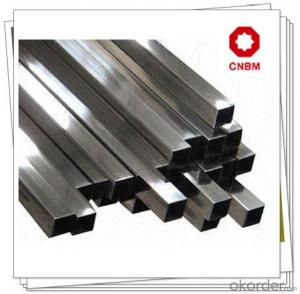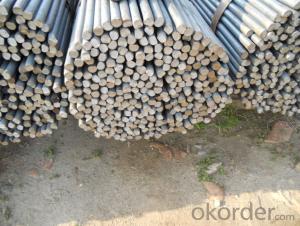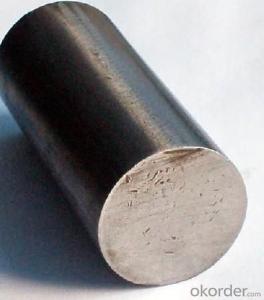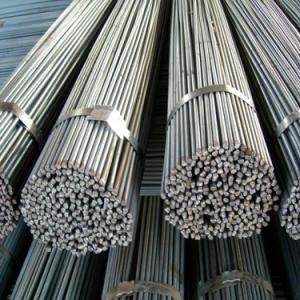Carbon Structural Steel Square Bars SS400CR
- Loading Port:
- Shanghai
- Payment Terms:
- TT OR LC
- Min Order Qty:
- 25 m.t.
- Supply Capability:
- 120000 m.t./month
OKorder Service Pledge
OKorder Financial Service
You Might Also Like
Carbon Structural Steel Square Bars SS400CR
Product Specification
1, p ≤0.050%; S ≤0.050%; Cr ≥0.30%
2, Strength of Extension σb ≥400 Mpa
Yield Strength σs ≥245(25) Mpa
Application
1, Widely used in construction and engineering structure.
2, Widely used in making reinforcing steel bar or building plant room rack, high voltage transmission tower, bridge, vehicle, boiler, vessel, ship, etc.
3, Widely used in manufacturing mechanical parts which do not require high performance.
4, SS400CR with grade C or D can be used as steel with special use.
Product Main Points
1, Heat Treatment: normalizing, annealing, tempering, quenching
2, Surface Treatment: black, bright, polished, galvanized
3, Product Process: hot rolled, cold drawn, forged
Product Show
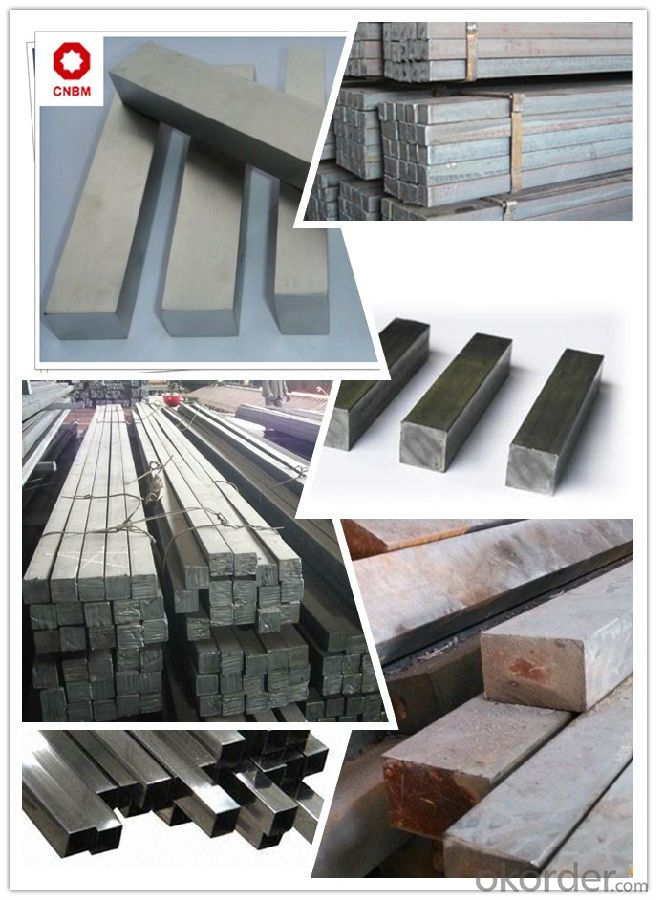
Work Shop
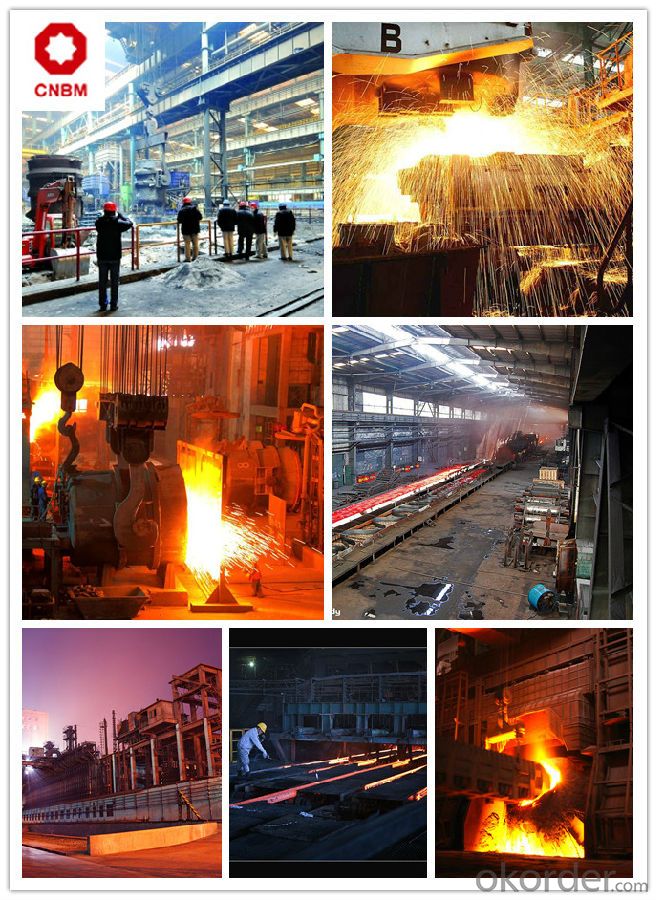
About Us


- Q:How do steel round bars resist corrosion?
- Steel round bars possess corrosion resistance due to a variety of factors. To begin with, steel itself is an alloy primarily composed of iron and carbon. By incorporating other elements like chromium, nickel, and molybdenum, the corrosion resistance of steel is enhanced. These additional elements create a protective oxide layer on the steel's surface, acting as a barrier against corrosive substances in the surroundings. Moreover, steel round bars can undergo further surface treatments or coatings to augment their corrosion resistance. One commonly used technique is galvanization, which involves coating the steel with a layer of zinc. This zinc coating serves as a sacrificial layer, deteriorating before the steel itself is affected. Additionally, steel round bars can be coated with epoxy or other polymer coatings to provide an additional layer of safeguarding. It is also crucial to recognize that the manufacturing process and quality of the steel round bars significantly influence their corrosion resistance. Proper heat treatment, refining techniques, and quality control measures guarantee a homogeneous microstructure and minimal impurities in the steel, thereby reducing the probability of corrosion. In conclusion, the combination of alloying elements, surface treatments, and high-quality manufacturing processes contribute to the corrosion resistance of steel round bars, rendering them a dependable choice for applications in corrosive environments.
- Q:What is the cost of steel round bars compared to other materials?
- The price of steel round bars can differ depending on various factors, including the grade of steel, the bar's size and dimensions, and market conditions. However, in general, steel round bars are usually more economical than other materials commonly used in construction and manufacturing. For example, when compared to materials like aluminum or titanium, steel round bars are typically more affordable. Steel is widely available, making it a cost-efficient choice for many applications. Additionally, steel possesses excellent strength and durability attributes, making it a preferred material for structural purposes. In contrast to materials like wood or plastic, steel round bars may be initially more costly. Nevertheless, when considering the long-term advantages such as its longevity, resistance to corrosion, and minimal maintenance requirements, steel still provides a cost-effective solution. It is important to note that the price of steel round bars can significantly vary depending on market conditions, including the availability of raw materials and the demand for steel products. Additionally, specialized or high-grade steel alloys may come at a higher cost due to their specific properties or manufacturing processes. To summarize, steel round bars generally offer a cost-effective option compared to many other materials used in construction and manufacturing. However, it is always advisable to research current market prices and consider specific project requirements before making any final cost assessments.
- Q:How do you calculate the cross-sectional area of a steel round bar?
- To calculate the cross-sectional area of a steel round bar, you can use the formula A = πr², where A represents the cross-sectional area and r is the radius of the round bar.
- Q:Are steel round bars suitable for machining operations?
- Yes, steel round bars are suitable for machining operations. They have excellent machinability due to their uniform shape and consistent mechanical properties, which make them easy to cut, drill, and shape into various components.
- Q:How do steel round bars compare to titanium round bars?
- Steel round bars and titanium round bars have different properties and characteristics that make them suitable for different applications. Here is a comparison between the two: 1. Strength: Titanium round bars have a higher strength-to-weight ratio than steel round bars. This means that titanium can withstand higher loads and stresses while being lighter in weight compared to steel. However, steel round bars are generally stronger and more rigid than titanium, making them suitable for heavy-duty applications that require high strength. 2. Corrosion Resistance: Titanium round bars are highly resistant to corrosion, even in harsh environments such as saltwater. Steel, on the other hand, is susceptible to corrosion and requires additional protective measures (such as coatings or galvanization) to prevent rusting. Therefore, titanium round bars are preferred in applications where corrosion resistance is essential. 3. Density: Titanium round bars have a lower density compared to steel round bars. This low density makes titanium ideal for applications where weight reduction is crucial, such as aerospace and automotive industries. Steel round bars, with their higher density, are typically used in applications where weight is less of a concern. 4. Temperature Resistance: Titanium round bars have excellent heat resistance, retaining their mechanical properties at high temperatures. Steel round bars, however, can lose their strength and become brittle when exposed to high temperatures. Therefore, titanium round bars are suitable for applications that require elevated temperature resistance. 5. Cost: Steel round bars are generally more affordable than titanium round bars. Titanium is an expensive metal due to its scarcity and complex extraction process. The cost difference between the two materials can be significant, making steel round bars more favorable for budget-conscious projects. In conclusion, the choice between steel round bars and titanium round bars depends on the specific requirements of the application. Steel is preferred for its superior strength and affordability, while titanium offers advantages such as high strength-to-weight ratio, corrosion resistance, temperature resistance, and lower density.
- Q:How do you calculate the weight of a steel round bar based on its length and volume?
- To calculate the weight of a steel round bar based on its length and volume, you need to know the density of the steel. The density represents the amount of mass per unit volume of the material. The formula to calculate the weight is: Weight = Volume × Density First, you need to calculate the volume of the steel round bar. The volume of a cylinder (which is the shape of a round bar) is given by the formula: Volume = π × (Radius)^2 × Length Where π is a mathematical constant approximately equal to 3.14, and Radius is the radius of the round bar. Once you have the volume, you can multiply it by the density of the steel to find the weight. The density of steel can vary depending on the specific type of steel being used. For example, the density of mild steel is around 7850 kg/m³. Therefore, the weight of the steel round bar is calculated as: Weight = Volume × Density For example, let's say we have a steel round bar with a length of 1 meter and a radius of 0.5 meters. To calculate the weight, we need to find the volume first: Volume = π × (0.5)^2 × 1 Volume = 0.7854 m³ Next, we multiply the volume by the density of steel: Weight = 0.7854 m³ × 7850 kg/m³ Weight = 6171.79 kg So, the weight of the steel round bar would be approximately 6171.79 kg.
- Q:What are the different types of surface defects in steel round bars?
- There are several types of surface defects that can occur in steel round bars, including scale, pits, seams, scratches, and decarburization.
- Q:Can steel round bars be used for making wire?
- Yes, steel round bars can be used for making wire by undergoing a process called wire drawing. In this process, the steel round bar is pulled through a series of progressively smaller dies, reducing its diameter and elongating it into wire form.
- Q:Can steel round bars be painted?
- Yes, steel round bars can be painted.
- Q:What are the different grades of stainless steel round bars for marine applications?
- There are several different grades of stainless steel round bars that are commonly used for marine applications. The most common grades include 304, 316, and 316L stainless steel. Grade 304 stainless steel is a versatile and widely used alloy that offers good corrosion resistance, high strength, and excellent formability. It is often used for marine applications where moderate corrosion resistance is required. Grade 316 stainless steel is similar to grade 304, but it contains additional molybdenum, which enhances its corrosion resistance, especially against chlorides and other aggressive environments commonly encountered in marine applications. This grade is often preferred for marine environments where increased resistance to corrosion is necessary. Grade 316L stainless steel is a low carbon version of grade 316, which further improves its resistance to sensitization and intergranular corrosion. This makes it highly suitable for marine applications where welding is required, as it minimizes the risk of corrosion at the welds. In addition to these grades, there are also specialized stainless steel alloys such as duplex stainless steel, which combines the benefits of austenitic and ferritic stainless steels. These alloys offer even higher corrosion resistance and strength, making them suitable for more demanding marine applications. When selecting the grade of stainless steel round bars for marine applications, it is important to consider the specific environmental conditions, such as exposure to saltwater, chemicals, or high temperatures. Consulting with a materials specialist or referring to industry standards can help ensure the right grade is chosen for the specific marine application.
1. Manufacturer Overview |
|
|---|---|
| Location | |
| Year Established | |
| Annual Output Value | |
| Main Markets | |
| Company Certifications | |
2. Manufacturer Certificates |
|
|---|---|
| a) Certification Name | |
| Range | |
| Reference | |
| Validity Period | |
3. Manufacturer Capability |
|
|---|---|
| a)Trade Capacity | |
| Nearest Port | |
| Export Percentage | |
| No.of Employees in Trade Department | |
| Language Spoken: | |
| b)Factory Information | |
| Factory Size: | |
| No. of Production Lines | |
| Contract Manufacturing | |
| Product Price Range | |
Send your message to us
Carbon Structural Steel Square Bars SS400CR
- Loading Port:
- Shanghai
- Payment Terms:
- TT OR LC
- Min Order Qty:
- 25 m.t.
- Supply Capability:
- 120000 m.t./month
OKorder Service Pledge
OKorder Financial Service
Similar products
New products
Hot products
